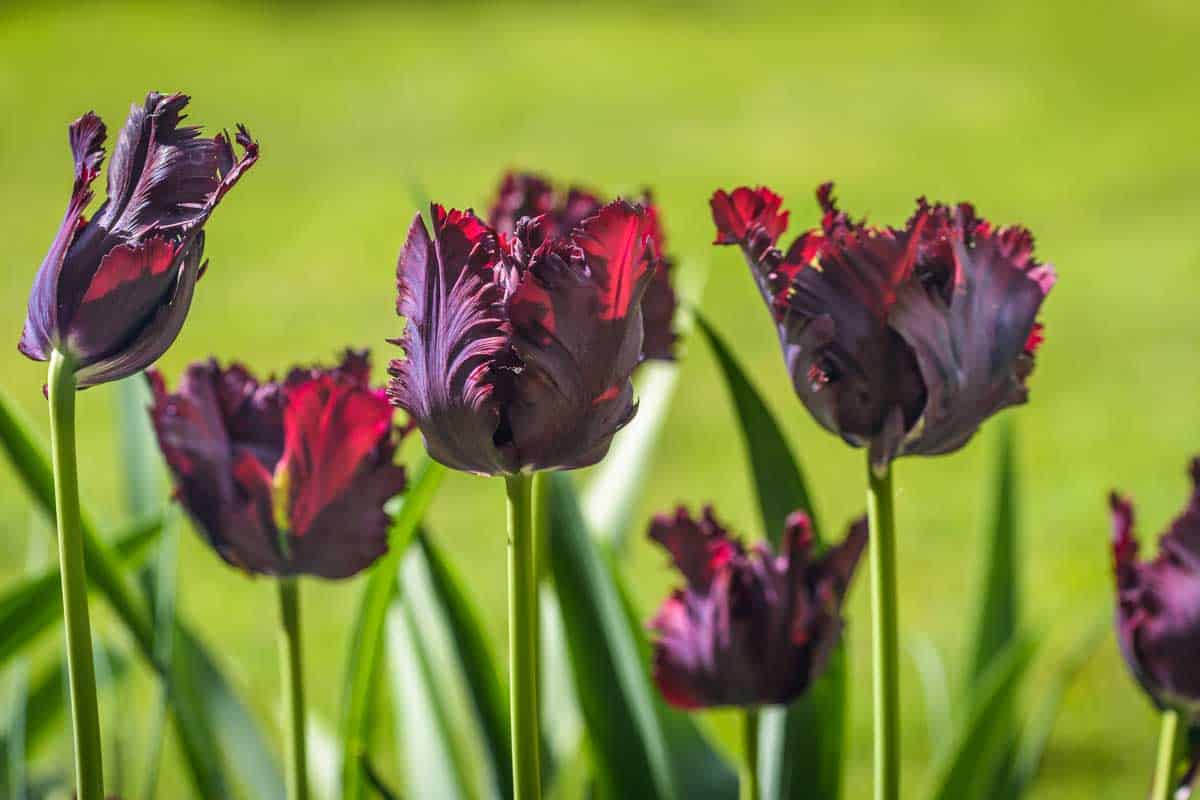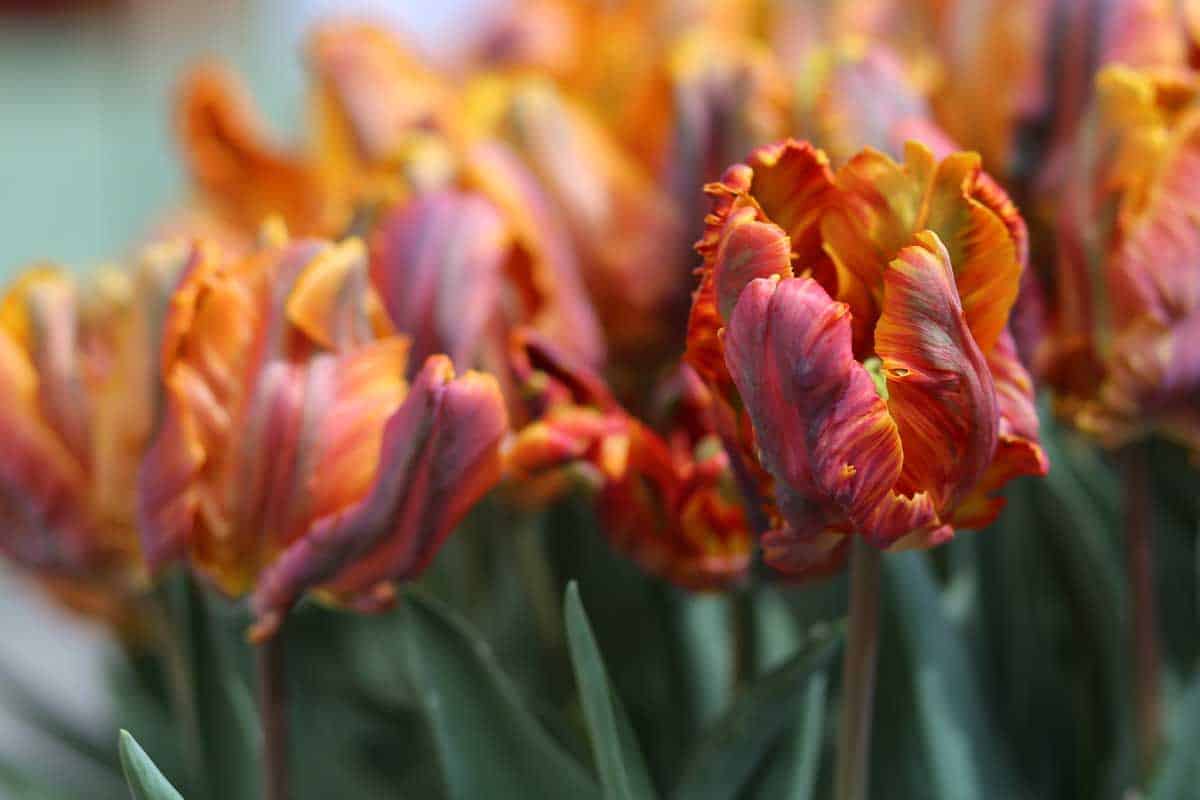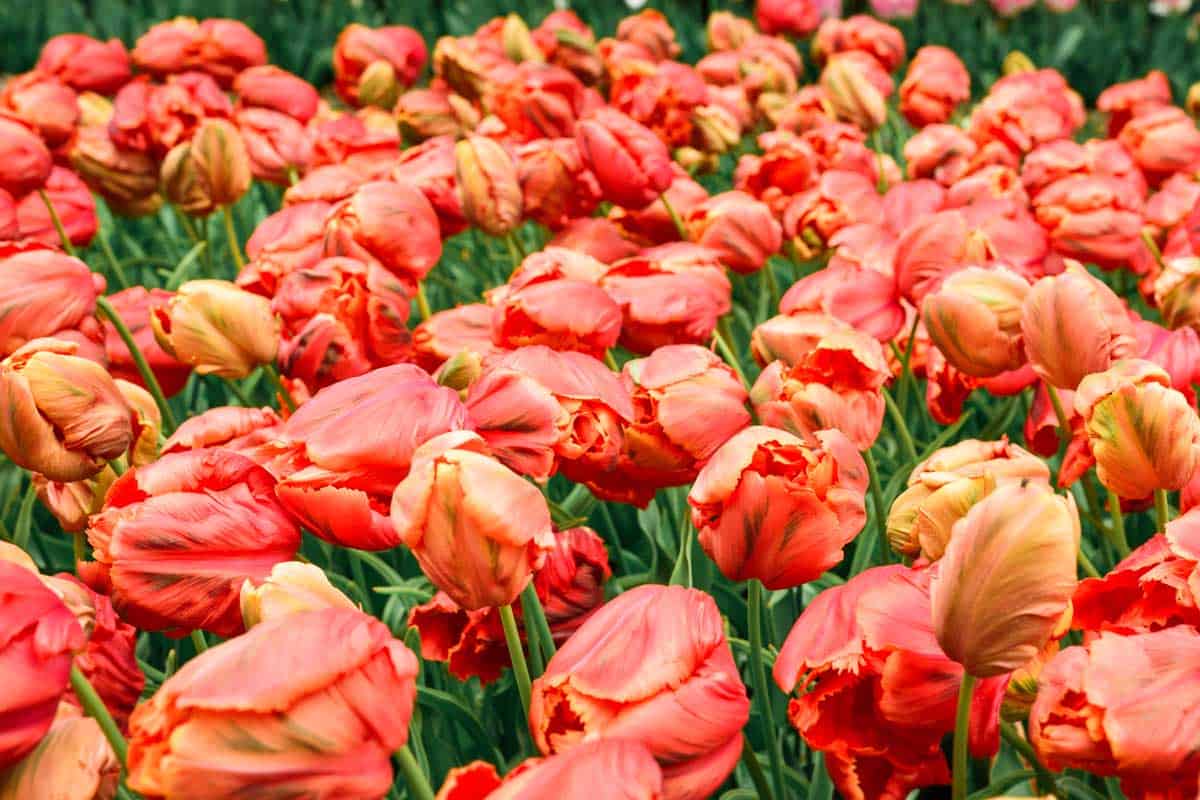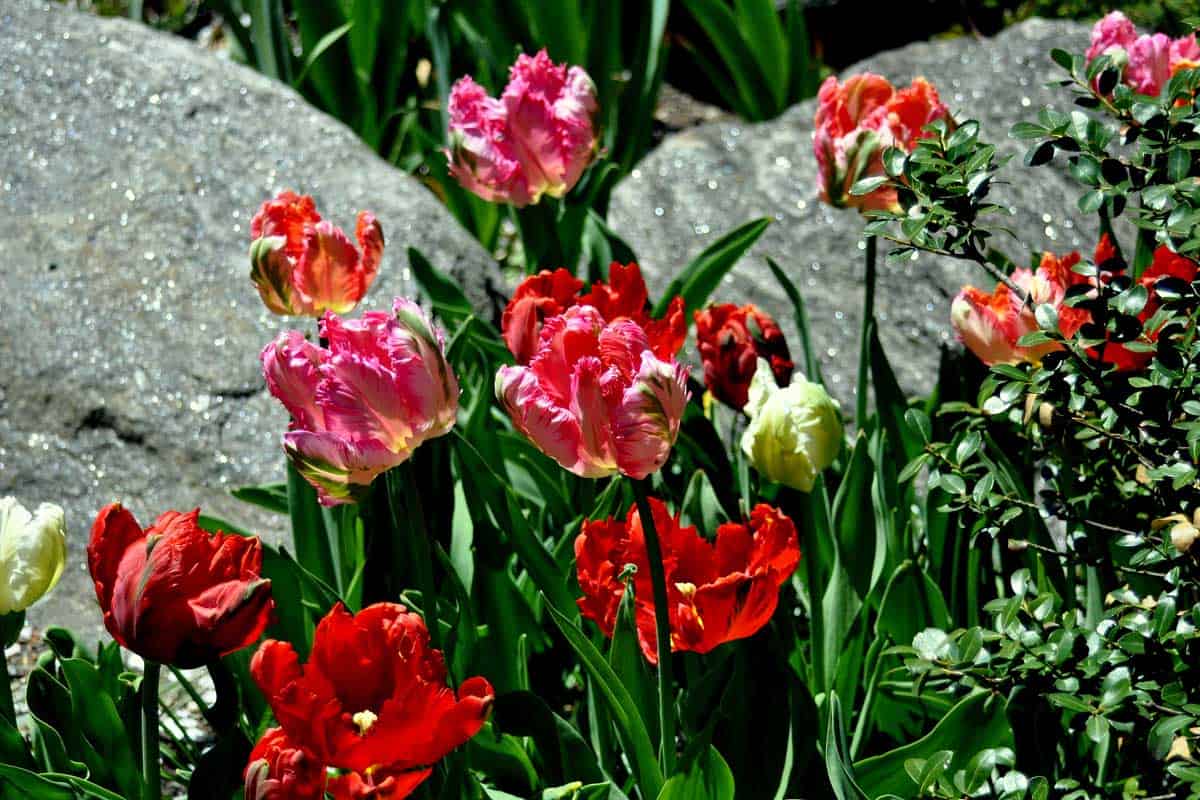![Parrot Tulips Garden Guide [Care Tips, Shopping Links and Pictures]](https://gardentabs.com/wp-content/uploads/2020/01/Parrot-Tulips-Garden-Guide-Care-tips-shopping-links-and-Pictures.jpg) Parrot tulips are a late-blooming version of early spring tulips. These tulips look like delicate ruffles and are thought to first grow in the 17th century from mutations of the later blooming tulips, arriving in the Netherlands from France.
Parrot tulips are a late-blooming version of early spring tulips. These tulips look like delicate ruffles and are thought to first grow in the 17th century from mutations of the later blooming tulips, arriving in the Netherlands from France.
These flouncy blooming bulbs are hardy in the U.S. in Zones 4-7.
These blooms take a little bit extra care. and are noticeably more delicate than early spring tulips. Finding a place out of the wind or pot planting so that you can bring tulips inside will help your flowers. During active growth, they will thrive with a little extra tender loving- care; they need to die back before being digging up for summer.
These beauties are found in almost any hue, including yellow, orange, red, violet, indigo, and nearly black. One of the most loved features of these flowers is that they bloom in late spring. Parrot tulips are a beautiful extension to the tulips season.
What Is A Parrot Tulip?
Tulips are a genus of perennial, geophytes, meaning the bulbs store nutrients. The flowers are bright colors with large petals, and showy. The tulip has a long history of cultivation as a member of the lily family.
The tulip has around seventy-five species, and the species are subdivided into four categories.
The word tulip is from Persia and means turban. There is a school of thought that believes that tulips were cultivated in Persia in the 10th century but only came to the West's attention in the 16th century.
How To Grow Parrot Tulips?

Growing these tulips is similar to growing standard species of tulips. A few simple caveats to typical tulip care and you are on your way to learning more about caring for parrot tulips.
For education on other species of tulips, visit our post on "When To Plant Tulip Bulbs?
Planting Parrot Tulips
Using Parrot tulips to transition your garden from early spring to summer, it is wise that you plant the bulbs starting from early fall stretching into November, this will give you middle to late spring Parrot tulips.
Where To Plant Parrot Tulips?
Parrot tulips are more delicate than other tulips species. It is best to plant parrot tulips away from strong wind, possibly even potting them, to allowing for bringing them indoors out of the wind.
The bulbs must be 5 inches deep, and around 4 to 6 inches deep. Be sure to find a place in full sun, and most importantly is well-drained soil. Tulips hate wet feet.
Plant Size, And Growth Length

Heightwise, the Parrot tulips will grow fourteen to sixteen inches tall, with blooms that open to 5 inches in circumference. If you desire continuous bloom of bulbs from early spring to late spring, take a look at the Bloom Time Chart by Longfield Gardens, at this link.
It is a good idea to mulch, fertilize, and water your newly planted bulbs, removing the mulch just before spring growth.
Growing Zones, And Conditions

Similarly, to tulips, the parrot species is hardy in zones 4-7 in the U.S. Parrot varieties will thrive in full sun, fertile soil. Tulips prefer medium watering and soil that drains. Tulip bulbs will rot if they sit in moisture to long. These geophytes prefer cold winters and warm, dry summers.
Soil Type
Tulips prefer fertile, loose soil. If the ground is too full of clay, you can add humus-rich material to keep the area draining. Allowing the bulb and roots to dry between watering.
If the soil does not remove water, you risk your bulbs rotting between blooming seasons and empty spots next season. Tulips do not like to be wet all the time.
Particularly, recommended by gardeners is using kitty litter to protect bulbs from critters. However, it also keeps the soil loose, allowing for draining. Remember to plant these long-stemmed delicate beauties away from the wind.
Light Requirements
Equal to the requirements for the most other famous tulips varieties, parrot tulip plants need full sun. Full sun means that they need to receive sunlight for a large portion of the day.
The part caring for tulips that needs the most balance is the amount of sun in ratio with the amount of water. When this balance is just right, you will have beautiful, bright, healthy crops of tulips to delight your eyes.
Water And Fertilizer For Parrot Tulips

Balancing watering and fertilizing tulips isn't that difficult. It just takes a little monitoring and planning. Ideally, fertilize tulips in the fall when they send out roots and start establishing before winter. Feeding is only needed once a year in the fall for tulips.
Water is both a necessity and a curse for tulips. If the bulb and roots are too wet, it can introduce rot, and mildew, and decay. In this case, dig these bulbs and replace with healthy ones, even moving the bulbs to dryer soil or amending soil as needed.
Planting, In Review
- Sort bulbs removing any rotten bulbs
- Plant in fall - November - 5inches deep, and 4-6 inches apart (plant in the pot if necessary)
- Fertilize planted bulbs, mulch to protect for winter, and water
- Wait till spring
- Water occasionally, allowing the soil to dry between waterings
- Enjoy Spring Blooms
- Cut Flowers, and let the green foliage to die naturally, this feed bulb for next season
Types Of Parrot Tulips
Apricot Parrot Tulips
Apricot Parrot tulips are an award-winning variety. With a soft creamy apricot color flushed with rose and ivory, topped with a gentle fragrance, these blooms are show stoppers for sure.
Black Parrot
Black parrot tulips varieties are known for their wine-colored center petals that are tinged with black at the edges. They almost look like shadows of flames.
Blue Parrot Tulips
Bright violet shades of blue, with a little bit of bronze purple inside these parrot tulips, are a favorite. Gardeners use these to create a palette of harmonies in a late spring garden.
Plant these beauties this fall to enjoy in spring. The bright blue petals of this tulip will brighten your garden and create a lovely color palette.
Bright Parrot Tulips
Lighting up your garden with these fire light parrot tulips will amaze your guests, and draw any eye to your landscape. The petals are a deep red in the center, gradually lightening to bright orange at the edges, like the tip of a flame.
Erna Parrot Tulips
Erna parrots are a rose-like variety that throws it's brilliant red color towards the sky in its celebration of spring finally arriving.
Estella Rijnveld Parrot Tulip
Swirling red and white colors dance around this tulip bloom like a flamenco dancer spinning around the dance floor. The flower that looks like a candy cane will have you thinking of the fond memories of Christmas.
Flaming Parrot Tulip
The petals red center and the yellow edges give these flowers a sense symmetry while still providing unique shapes and pops firey of color to any spring garden.
Green Wave Parrot Tulips
If you are one of those people that loves greenery in a simple yet visually stunning color palette, these might be the tulips for you. The center of the petals looks like an extension of the stems with a vibrant green that melts to the outer petals soft white, and gentle pink tones.
Quintessential, the greens, and pinks of this tulip will make you smile every time you walk in your garden and see these tulips waving at you.
Professor Rontgen Parrot Tulips
Coral and pink and copper are alight and bright in this beautiful, sophisticated flower. These make superb cut flowers that will brighten any space.
Rococo Parrot Tulips
Royal cardinal reds and sage greens are the tonal colors of these majestic tulips. Giving your landscape a look of royalty and formality, these are a beautiful choice for formal gardens.
Super Parrot Tulips
Beautifully paired with greenery Super Parrot Tulips add simple, understated elegance to any cut flower arrangement. A beautiful addition to a wedding and formal dinner decor, or to add white to your color palette in your garden.
Webers Parrot Tulips
These cream-white blooms often look pink because of the streaks of bright pink on the edge of the petals.
White Parrot Tulips
Pure white petals, with green accents the colors, accentuate the green foliage of the tulips.
FAQ About Parrot Tulips
- Are Parrot tulips perennials? Yes, Parrot tulips are perennial herbaceous geophytes.
- Will Parrot tulips come back next year? Yes, with the caveat that too much water can kill them. In this case, you will need to dig up the rotting bulbs and replace them with healthy ones.
- When are Parrot tulips in season? Parrot tulips are in season in late spring.
Where To Buy Parrot Tulips?
You can find beautiful mixes of parrot tulips, or buy specific varieties on Amazon.com,
To visit the Amazon product page for the blend of varieties, click here.
Fall Planting, Are You Ready?
![Parrot Tulips Garden Guide [Care Tips, Shopping Links and Pictures]](https://gardentabs.com/wp-content/uploads/2020/01/Fiery-red-and-yellow-parrot-tulips.jpg)
Now have plenty of information on Parrot tulips. For planting ideas, visit our page 30+ Stunning Tulips Planting Ideas. Do you already have a favorite variety you want to try? Do you have experience growing Parrot Tulips, or have a loved variety?
Comment and share your experience or Parrot tulips growing plans with us, so we can all grow and learn together. Best of luck with your beautiful, Parrot tulip garden!

